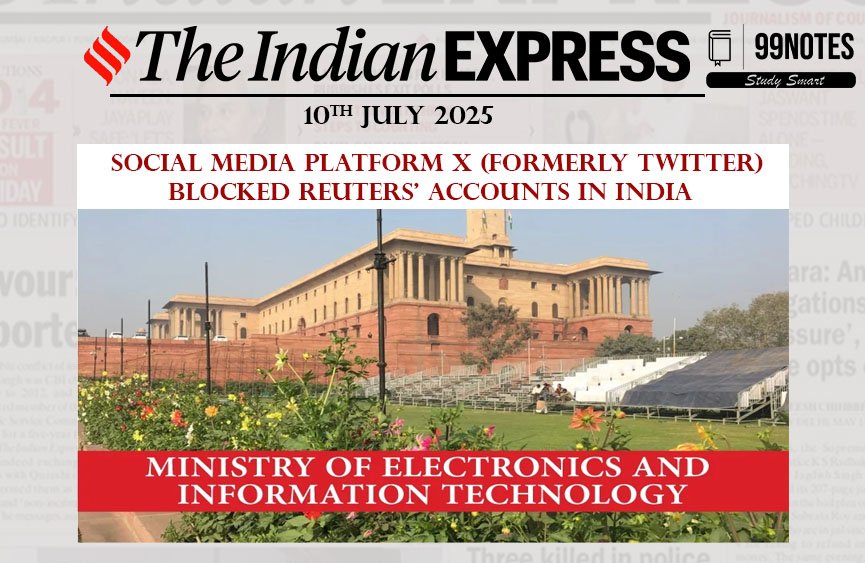10 July 2025: Indian Express Editorial Analysis
1. In No Clear Terms
(Source: Editorial Page, The Indian Express)
| Topic: GS Paper 2: International Relations | GS Paper 3: Indian Economy – External Sector |
| Context |
|
Trump’s Unpredictable Tariff Strategy
- During his presidency and the 90-day tariff pause period, Trump emphasized bilateral over multilateral trade deals, causing global anxiety.
- Tariffs on goods like steel, aluminum, and tech components were introduced or expanded on short notice.
- His administration sent letters to 14 countries announcing the reinstatement of tariffs, effective from August, further undermining trust in trade norms.
Impact on Global Trade Architecture
- The sudden imposition of tariffs has disrupted existing trade deals, particularly those involving ASEAN and BRICS nations.
- Even close U.S. allies like Japan and South Korea faced tariffs, signaling a disregard for traditional alliances.
- A key concern is the legality of these actions under WTO norms, especially as the U.S. bypassed multilateral dispute settlement processes.
Implications for Developing Economies
- Developing nations dependent on U.S. trade, such as those in ASEAN and Latin America, now face instability in tariffs and trade access.
- Tariffs ranging from 25% to 40% hit exports of aluminum, autos, and electronics, stifling growth in emerging economies.
- The editorial highlights how India and Southeast Asia are being pushed to diversify export markets and reduce dependency on the U.S.
Geopolitical Tensions and China’s Role
- Trump’s tariff hikes seem partly targeted at Chinese transshipped goods, raising regional tensions and fears of economic retaliation.
- A recent Chinese investment paper warned of an uptick in “transshipment activities,” which could be used as a pretext for more tariffs.
- This adds complexity to U.S.–China–ASEAN relations, impacting India’s positioning in the Indo-Pacific economic sphere.
Erosion of Multilateralism
- The editorial emphasizes that the World Trade Organization (WTO) and Free Trade Agreements (FTAs) are being undermined.
- India, along with other nations, must prepare for a fragmented trade world with little predictability and weakening global institutions.
- The Global Trade and Research Initiative notes that such actions may “dismantle the global trading framework” if unchecked.
Conclusion & Way Forward
- India must adopt a cautious and strategic approach to international trade in light of such volatility.
- Strengthening regional groupings like BIMSTEC, investing in trade self-reliance, and pushing for WTO reforms should be part of the long-term strategy.
- A diversified export base and bilateral resilience-building are necessary to navigate this uncertain environment.
| Practice Question: (GS-3 | 15 Marks | 250 Words)
How has the rise of unilateral trade measures by the United States, particularly under the Trump administration, impacted the global trading system? What strategies should India adopt to safeguard its trade interests? |
Also Read: The Hindu Editorial Analysis- 10 July 2025
2. Block, Unblock
(Source: Editorial Page, The Indian Express)
| Topic: GS Paper 2: Governance | GS Paper 3: Cybersecurity and IT Laws | GS Paper 4: Ethics in Public Administration |
| Context |
|
Incident Overview
- Social media platform X (formerly Twitter) blocked Reuters’ accounts in India citing a “legal demand”, later attributed to a government takedown request during Operation Sindoor.
- The Ministry of Electronics and Information Technology denied issuing such a directive, but Reuters was among over 2,000 accounts blocked temporarily.
- The event triggered a debate about state overreach, lack of clarity, and possible suppression of press freedom.
Legal and Constitutional Concerns
- Frequent and vague takedown orders may violate the principles laid down in the Shreya Singhal case, where Section 66A of the IT Act was struck down for being unconstitutional.
- Section 69A still allows blocking content under specific conditions, but must align with Article 19(1)(a), which guarantees freedom of speech, subject to reasonable restrictions.
- The editorial warns that blanket bans and broad interpretations of security risks may violate both natural justice and constitutional safeguards.
National Security vs. Free Speech
- While takedowns may be valid in some situations — such as when inciting communal violence or during security crises — the editorial emphasizes that such measures must be narrowly applied.
- Examples like the Pulwama and Pahalgam terror attacks have previously prompted content restrictions, showing the fine balance between protecting sovereignty and enabling expression.
Ethical and Governance Issues
- The opacity surrounding the origin of such orders reflects a lack of transparency and accountability in digital governance.
- Misuse of security justifications for political or reputational shielding creates a chilling effect on journalism and public discourse.
- The editorial criticizes the “chilling signal” this sends to global media platforms, investors, and the public.
Policy Recommendations
- Takedown orders should be accompanied by clear reasoning and made public unless classified under justified secrecy.
- There is a need to review Section 69A and update IT rules in line with global best practices on digital rights and freedom of expression.
- Institutions like the Parliamentary Standing Committee on IT should demand accountability and legislative oversight over digital censorship mechanisms.
Conclusion/Way Forward
- In a democracy, digital governance must be rooted in transparency, proportionality, and accountability. While national security is a legitimate concern, it should not be used as a cover for arbitrary censorship. India must reassert its commitment to constitutional freedoms by reforming digital content regulation frameworks and ensuring independent oversight.
|
Practice Question: (GS-2 | 10 Marks | 150 Words) |
Read more – 09 July 2025 : Indian Express Editorial Analysis


